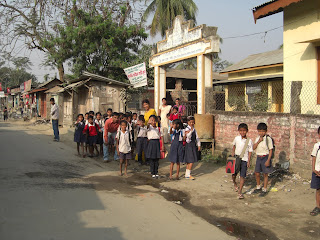When asked what my travel arrangements were for this evening I received gales of laughter when I mentioned I was taking the 10.30 overnight Kanchanjung Express train. ‘What’s the problem?’ I enquired. ‘Oh that train was held up the other night in Kokrajhar. No probs though, sure it’ll run fine tonight!’ It appears it’s not just the northern oil-producing area around Digboi where the kidnappings happen. Apparently there’s also trouble to the east, on the Bhutan border, where there’s ‘just some people on the independence bandwagon’ according to Abhijit, the witty well-educated political scientist of the office. The previous night two people were killed in an encounter with the security forces and a doctor was kidnapped by unidentified miscreants suspected to be part of the United Liberation Front of Asom (ULFA).
 The Assamese state symbol is the rhino. Abhijit mused the rhino’s slow pace suits the Assamese attitude to life but this description certainly wasn’t fitting with Surjya’s programme for me for the day! We began at 7am. The car was packed with Surjya (the DRC head), Tapashi, (smart working Mum for the joint Pratham-ACER survey), Mukut (Kamrup district coordinator), Abdul (the mad driver) and me (the eager English girl). We left Guwahati for Hajo, a small town 35km away where we visited 2 Pratham Learning Centres (PLCs). 120 children from the 1st to 5th Standard (6 to 11 years) attend classes at the 2 centres before school from 8 – 9.45am. Next we visited Suwal Kucha, nicknamed ‘silk city’ by Mukut (despite the fact it was more of a village), where the PLC runs Saturday
The Assamese state symbol is the rhino. Abhijit mused the rhino’s slow pace suits the Assamese attitude to life but this description certainly wasn’t fitting with Surjya’s programme for me for the day! We began at 7am. The car was packed with Surjya (the DRC head), Tapashi, (smart working Mum for the joint Pratham-ACER survey), Mukut (Kamrup district coordinator), Abdul (the mad driver) and me (the eager English girl). We left Guwahati for Hajo, a small town 35km away where we visited 2 Pratham Learning Centres (PLCs). 120 children from the 1st to 5th Standard (6 to 11 years) attend classes at the 2 centres before school from 8 – 9.45am. Next we visited Suwal Kucha, nicknamed ‘silk city’ by Mukut (despite the fact it was more of a village), where the PLC runs Saturday  and Sunday classes. In this area silk weaving is the major employer – and indeed the main occupation of the Pratham volunteers – so a visit to a silk factory seemed fitting.
and Sunday classes. In this area silk weaving is the major employer – and indeed the main occupation of the Pratham volunteers – so a visit to a silk factory seemed fitting.
Back in the car we drove at the pace of Abdul’s Indian tech music to Darang, 15km from Bhutan. Passing tea plantations on the way we crossed a loud All Assamese Students Union (AASU) protest. A large concern in this district is rising food and  commodity prices which severely hurt local people working in the plantations on very minimal weekly salaries. On arrival at the government school that Pratham works in association with I was able to meet 8 volunteers from neighbouring villages. Sitting on the grass in the playground I asked them what their greatest challenge had been. They were unanimous that, though terrorism is often cited, it is not a good enough excuse for poor education in the state. Rather the socio-economic issues – such as alcoholism in poor communities – are disabling their efforts.
commodity prices which severely hurt local people working in the plantations on very minimal weekly salaries. On arrival at the government school that Pratham works in association with I was able to meet 8 volunteers from neighbouring villages. Sitting on the grass in the playground I asked them what their greatest challenge had been. They were unanimous that, though terrorism is often cited, it is not a good enough excuse for poor education in the state. Rather the socio-economic issues – such as alcoholism in poor communities – are disabling their efforts.
After some fantastic Assamese chi at Mukut’s family house, we began the 100km drive back to Guwahati. I began pondering everything I’d learnt. Despite such large challenges – from political to socio-economic – nothing deters Pratham’s reach to this, the most beautiful region of India I’ve visted so far.
______________________________________________________
www.pratham.org
www.pratham.org.uk
www.prathamusa.org




1 comment:
There many good Schools in Assam city find online information on Assam Schools.
Post a Comment